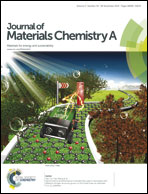Palladium nanoparticles supported on graphitic carbon nitride-modified reduced graphene oxide as highly efficient catalysts for formic acid and methanol electrooxidation†
Abstract
A covalently coupled hybrid of graphitic carbon nitride (g-C3N4) and reduced graphene oxide (rGO) is fabricated via an in situ chemical synthesis approach and used to load Pd nanoparticles. It is found that the Pd nanoparticles with an average diameter of 3.83 nm are evenly deposited on the g-C3N4–rGO surface. Compared with the Pd–rGO and commercial Pd–AC (Pd–activated carbon) catalysts, the ternary Pd–g-C3N4–rGO nanocomposite exhibits excellent electrocatalytic properties toward both formic acid and methanol electrooxidation, such as extremely large electrochemically active surface area (ECSA) values, significantly high forward peak current densities and reliable long-term stability. The enhanced electrochemical activity can be attributed to the specific characteristics of the unique nanostructure of Pd–g-C3N4–rGO and the concerted effects of the individual components, including the superior conductivity of rGO, the high specific surface area of the mesoporous structure, the good structural stability due to the covalent interactions between g-C3N4 and rGO, and the highly dispersed Pd nanoparticles as a result of the effect of planar groups of g-C3N4.


 Please wait while we load your content...
Please wait while we load your content...